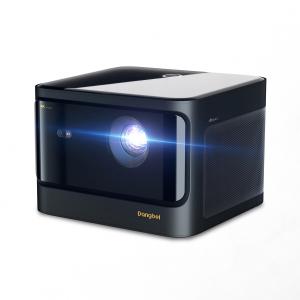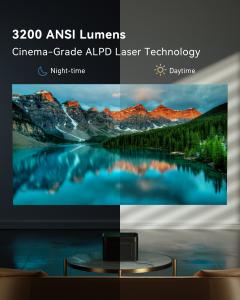Projectors are powered by different projection technologies. What are they? And what are the pros and cons of them?
NEW YORK, UNITES STATES, July 18, 2022 /EINPresswire.com/ -- What are available projection technologies? What are the principles? What are the advantages and disadvantages?Currently, there are three dominant projection technologies: LCD (Liquid Crystal Display), DLP (Digital Lighting Process), and LCOS (Liquid Crystal on Silicon).
LCD(Liquid Crystal Display)
LCD projectors are divided into two categories: liquid crystal panel projectors and liquid crystal light valve projectors. The principle is to use the LCD panel as the imaging device, using the tension of the liquid crystal, thus affecting the optical properties, to produce images with different gray levels and colors. According to the number of LCD panels, there can be two types of projection technology: single LCD and 3LCD.
Pros:
1.Rich colors. Virtually all LCD projectors offer true color in 16.7 million colors with more accurate color reproduction.
2.Good technology maturity. LCD technology has been developed for more than 30 years, each product has been applied and optimized for a long time, and the performance is relatively stable.
Cons:
1.Large loss of brightness. As the grid covering the LCD surface blocks light transmission, most of the light is lost and the brightness performance of the LCD projector is seriously affected.
2.Not dustproof. In order to enhance the brightness of the entire projector, LCD projection would require a significant increase in lamp source brightness. And at this time, in order to solve the high temperature, fan cooling needs to be introduced, thus making it impossible to achieve a sealed environment. After using for a long time, the dust adsorbed on the LCD will affect the LCD imaging quality.
3.Large product size, especially 3LCD. Due to the difficulty in reducing the size of the optical path system, the overall size and weight of the projector are relatively large.
DLP (Digital Lighting Process)
DLP technology utilizes digital optical imaging principles to digitize source images, and then these binary images are fed into a DMD, where they are combined with colored light that comes from the light source image and is carefully filtered. These images exit the DMD and are imaged onto the screen. The external signal source is directly modulated for imaging without digital-to-analog (D/A) conversion. On the one hand, it minimizes signal attenuation and makes noise disappear, and on the other hand, it can obtain fine image quality with digital gray level and color reproduction, thus presenting a clearer, sharper, and more layered picture display.
DLP technology is also divided into single-chip DLP and three-chip DLP. three-chip solution has significantly better color contrast and brightness than single-chip solution, but the cost is too high. Currently, single-chip DLP solutions are more commonly used.
Pros:
1.High native contrast ratio
2.Miniaturization of volume. DLP projectors adopt the reflective principle, which makes it simpler to achieve high opening rates. The DLP optical path system is smaller for the same configuration, thus the whole device size can be made smaller.
3.Good anti-dust loop. The DMD chip uses a semiconductor structure, and the lens is not likely to change much when operating at high temperatures. The optical path of DLP are closed design, which reduces the probability of dust entering.
4.Portability. DLP projection can be made light, small and portable to meet consumer demand for mobile projection.
Cons:
Low color effect. The colors are not vibrant and vivid enough. In addition, the low-speed color wheel may also cause the rainbow effect of red, green and blue trailing shadows.
LCOS (Liquid Crystal on Silicon)
Silicon-based liquid crystal, a matrix liquid crystal display device with very small size based on reflection mode, is a new type of reflective micro LCD projection technology. This technology has not developed much in recent years. Now there are basically no more of these projectors, which have proven to be defective in design, unstable in machine performance, and a transitional product for 3LCD projectors.
Pros:
1.Great visual effect. High efficiency of light utilization, vivid colors, excellent grayscale, deep blacks, bright picture and less gridding.
2.Miniaturization of size. The high light utilization allows for a good improvement in projection resolution. The silicon chip does not need to be designed for large light transmission, so that the size of the optical machine can be made small.
Cons:
1.The complexity of the processing process leads to low yields.
2.High cost. A large number of components can not be standardized production, coupled with the yield rate is difficult to improve, the overall cost is too high.
To sum up, DLP projectors have gradually become the mainstream projection technology. Despite the advantages and disadvantages, the technology of DLP is constantly improving. Many projector brands are gradually adopting DLP technology, such as Anker Nebula Cosmos Laser 4K, Dangbei Mars Pro, etc.
Chelsea
Hangzhou Dangbei Network Technology Co.,Ltd.
mall@dangbei.com
Visit us on social media:
Facebook
Twitter
LinkedIn
Other






